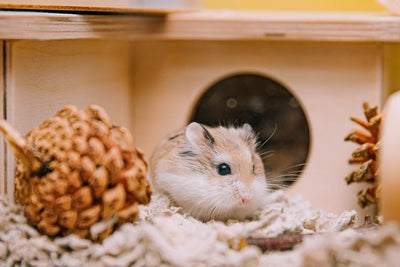Understanding Female Betta Fish

Female Betta Fish, though often overshadowed by their male counterparts, are fascinating aquatic creatures that deserve attention and proper care. In this comprehensive guide, we delve into the world of Understanding Female Betta Fish, providing insights on how to keep and care for these beautiful fish. Female Bettas may not have the flamboyant colors of males, but they possess their own unique charm and individual personalities. From tank setup to feeding habits, we explore the specific needs of female Bettas, shedding light on the best practices for creating a healthy and enriching environment for these finned companions. Whether you're a beginner looking to start your own Betta fish tank or an experienced aquarist wanting to expand your knowledge, this guide aims to be your go-to resource for all things related to Understanding Female Betta Fish. Get ready to embark on a journey into the aquatic realm of female Bettas, where beauty, grace, and care intertwine.
Understanding Female Betta Fish
Physical Appearance
Female Betta fish, scientifically known as Betta splendens, are captivating creatures cherished by aquarists for their brilliant colors and striking fins. In comparison to their male counterparts, female Bettas generally exhibit shorter fins, but compensate with a diverse array of hues, ranging from fiery reds to serene blues and vibrant yellows. Their slender, streamlined bodies enhance their elegance as they gracefully navigate through aquarium waters, mesmerizing onlookers with their beauty.
Behavioral Traits
Beyond their physical allure, female Bettas are renowned for their intriguing social dynamics. When housed together in a sorority under suitable conditions, these fish establish a hierarchical structure within their group, sometimes displaying territorial aggression. However, with ample space, adequate hiding spots, and live plants for enrichment, female Bettas can coexist harmoniously. Maintaining a close watch on their interactions and ensuring each fish has sufficient space to claim its territory are essential practices in fostering a peaceful sorority.
Feeding Habits
A well-rounded diet is imperative for the health and vitality of female Betta fish. In their natural habitat, female Bettas primarily subsist on insects and larvae. In a captive setting, these enchanting fish can thrive on a varied diet comprising premium pellets, frozen treats like brine shrimp, or live delicacies such as bloodworms. Preventing obesity and digestive complications necessitates vigilance against overfeeding, underscoring the importance of portion control in their dietary regimen.
Reproduction
Delving into the reproductive behavior of female Betta fish unveils a fascinating aspect for aspiring breeders. As egg-laying species, female Bettas engage in controlled spawning rituals with male counterparts. During this process, the female releases eggs that are fertilized by the male, culminating in the propagation of their species. Creating conducive breeding conditions and promptly removing the female post-spawning are pivotal steps in curbing potential post-spawning aggression.
Health Considerations
Despite their allure, female Betta fish are susceptible to an array of health maladies, including fin rot, ich, and velvet. Upholding optimal water quality, providing a nutritionally balanced diet, and closely monitoring their behavior are instrumental in safeguarding these fish against diseases. Implementing a quarantine protocol for new additions to the tank can mitigate the risk of disease transmission among female Bettas, preserving the well-being of the entire aquatic community.
Understanding the intricate facets of female Betta fish, encompassing their physical attributes, social behaviors, dietary requirements, reproductive tendencies, and health maintenance practices, is pivotal for aquarists dedicated to nurturing a thriving aquatic environment for these enchanting creatures.
Caring for Female Bettas
Female bettas, also known as Siamese fighting fish, are captivating creatures that require specific care to thrive in a home aquarium. By understanding their unique needs and providing a suitable environment, you can ensure that your female bettas lead healthy and fulfilling lives. Let's explore the essential aspects of caring for female bettas in detail.
Tank Setup Essentials
Creating the ideal habitat for your female bettas is crucial for their well-being. Here are some key tank setup essentials to consider: - Tank Size: Provide your female bettas with ample space by opting for a tank size of at least 5 gallons. Larger tanks offer more swimming room and help maintain stable water parameters. - Filtration and Heating: Invest in a reliable filtration system to keep the water clean and well-oxygenated. Additionally, maintain a consistent water temperature between 75-80°F using a quality heater. - Enrichment: Enhance your bettas' environment with live or silk plants, caves, and other decorations. These additions not only create hiding spots but also stimulate natural behaviors.
Feeding and Dietary Requirements
A well-rounded diet is essential for the health of your female bettas. Consider the following feeding and dietary requirements: - Balanced Nutrition: Offer a variety of high-quality betta pellets, flakes, and frozen foods to ensure your fish receive essential nutrients. Rotating food options can prevent dietary deficiencies. - Supplemental Foods: Treat your female bettas with occasional live or frozen foods like daphnia, brine shrimp, or bloodworms. These protein-rich snacks promote optimal health and coloration. - Feeding Regimen: Feed your bettas small portions 2-3 times a day, adjusting the quantity based on their appetite. Remove any uneaten food promptly to maintain water quality.
Health and Wellness Guidelines
Monitoring your female bettas' health is vital for early detection of any issues. Follow these guidelines to promote their well-being: - Regular Maintenance: Test the water parameters regularly and conduct partial water changes as needed to prevent ammonia spikes and ensure a stable environment. - Behavioral Observations: Observe your bettas daily for any abnormal behavior, such as excessive hiding, aggression, or fin damage. Address any concerns promptly to prevent health issues. - Quarantine Procedures: Before introducing new fish or plants, quarantine them in a separate tank to prevent the spread of diseases. This precaution safeguards the health of your existing bettas.
By adhering to these tank setup essentials, feeding practices, and health guidelines, you can provide optimal care for your female bettas and enjoy their beauty and unique personalities for years to come.
Breeding Female Bettas
Understanding the Breeding Process of Female Bettas
Female Betta fish, also known as Siamese fighting fish, are fascinating creatures that exhibit unique breeding behaviors. Understanding the breeding process is crucial for anyone looking to breed female Bettas successfully. Here are some insights into the breeding process:.
-
Conditioning the Females: Before the breeding process begins, it's essential to condition the female Bettas properly. This involves providing them with a nutritious diet and ensuring they are in optimal health.
-
Introducing the Female to the Male: Female Bettas are known to be selective when it comes to choosing a mate. It's important to introduce the female to the male Betta carefully to prevent any aggressive behavior.
-
The Nest Building: Male Bettas are responsible for building bubble nests where the eggs will be deposited. Observing this behavior can give insights into the readiness of the male for breeding.
-
The Spawning Process: Once the male has built the nest and the female has accepted him, the spawning process begins. The male wraps his body around the female, releasing sperm to fertilize the eggs as they are released.
Tips for Successful Breeding of Female Bettas
Breeding female Bettas can be a rewarding experience, but it requires careful planning and attention to detail. Here are some tips for successfully breeding female Bettas:.
-
Maintain Ideal Water Conditions: Female Bettas are sensitive to water quality, so it's crucial to maintain clean water with the right temperature and pH levels.
-
Provide Hiding Places: After the breeding process, it's essential to provide hiding places for the female Bettas to rest and recover from the stress of breeding.
-
Separate the Female: Once the breeding is complete, it's important to separate the female Betta from the male to prevent any aggressive behavior or stress.
-
Monitor the Fry: After the eggs have hatched, it's vital to monitor the fry closely and provide them with the necessary food and care for their growth and development.
Breeding female Bettas can be a challenging yet fulfilling endeavor for any fish enthusiast. By understanding the breeding process and following these tips, you can increase the chances of successfully breeding female Bettas and witnessing the beauty of new life in your aquarium.
Conclusion
Female betta fish make wonderful additions to any aquarium with their vibrant colors and engaging personalities. By understanding their unique traits and providing proper care, female bettas can thrive in a well-maintained tank environment. Whether you are a beginner or experienced aquarist, the joy of keeping and caring for female bettas is a rewarding experience that fosters a deeper appreciation for these enchanting creatures.






